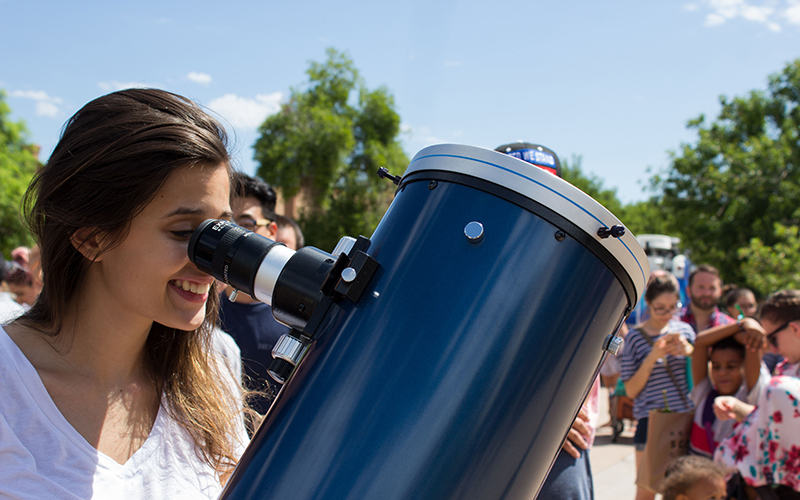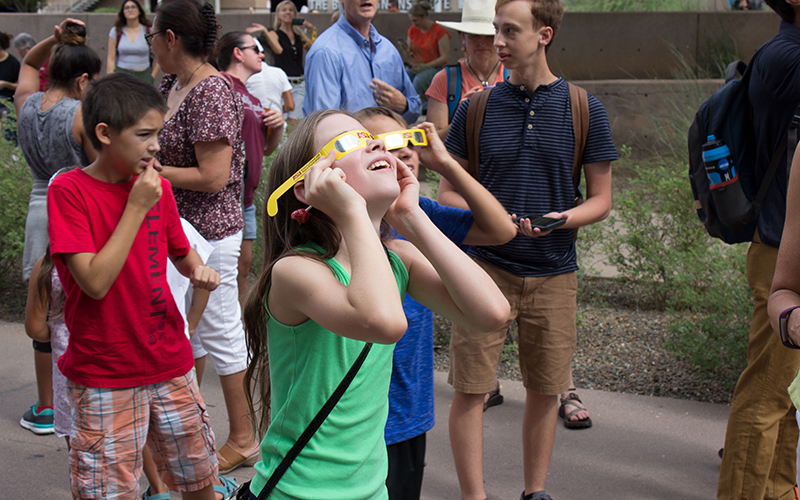
PHOENIX – People began lining up near the Hayden Library on Arizona State University’s Tempe campus by 7 a.m. Monday to snag some free solar-safe glasses and watch the Great American Eclipse.
By the time the eclipse actually started at 9:13 a.m., ASU had run out of its stock of 2,500 glasses at its two viewing locations. The estimated 5,000 attendees began sharing so they wouldn’t miss the rare opportunity.
“Look at the diversity of the crowd here. People from all different backgrounds have all gathered here to celebrate science, and I think that in itself is amazing,” said Cassandra O’Neill, a leadership consultant and author who brought her granddaughter, fourth-grader Dakota Yates, to the event.
For Arizona locals, the eclipse finished at noon. The maximum eclipse coverage — where the moon covered about 70 to 75 percent of the sun – occurred at 10:33 a.m.
Thousands turned out to local eclipse viewing parties, including the two on ASU’s Tempe campus and one at the Arizona Science Center in downtown Phoenix.

Ariel Patterson, a junior at Arizona State University who is studying biochemistry, looks into a telescope at the Arizona Science Center’s viewing party in downtown Phoenix. (Photo by Kianna Gardner/Cronkite News)
Although eclipses occur usually once or twice a year in various parts of the world, this was the first total solar eclipse to run the span of the United States since 1918. This also was the first North American eclipse to occur since the creation of the internet, allowing those who missed viewing it live the chance to view it online later.
According to NASA experts, the eclipse began on the coast of Oregon. From there, it ran along the so-called path of totality, a 70-mile-wide span that traversed 14 states, eventually ending in South Carolina.
Those who live along the line of totality witnessed a full solar eclipse, in which the moon and sun completely aligned. For those who live outside the line of totality, Arizona included, viewers experienced a partial eclipse.
“I know people who have become astronomers solely because they witnessed a solar eclipse. It’s a really incredible event,” said Sumner Starrfield, a Regents’ Professor of astrophysics at ASU. “There have been people waiting years and years to see this.”
Starrfield was one of many scientists at the viewing events. Astronomers, cosmologists, astrophysicists and groups from the School of Earth and Space Exploration gathered to educate attendees.

Fourth grader Dakota Yates borrows a pair of solar-safe glasses to view the eclipse at one of the viewing parties on Arizona State University’s Tempe campus. (Photo by Kianna Gardner/Cronkite News)
The ASU viewing locations also offered special solar telescopes for a better view of the event and provided a live stream of NASA’s eclipse coverage.
“It’s a neat opportunity for us to be involved in a scientific event that people are actually really excited about,” said Karin Valentine, a spokeswoman for the School of Earth and Space Exploration at ASU.
The Arizona Science Center also displayed live coverage of the eclipse from various sources, including NASA. The center provided crafting areas for children, who built rockets and solar-viewing gear.
The next North American eclipse will occur on April 8, 2024. This time, the line of totality will sweep from Texas to Maine, offering Arizona an even fuller view of a total eclipse.
